
Are you considering a house cleanout? If so, deep cleaning and organizing are key for an efficient process. In this blog post, we'll share some tips on how to get started. Keep reading to learn more!
Deep cleaning your house can be a great way to refresh and reset your space while improving your home's hygiene and overall tidiness. To make the deep cleaning process most effective, it is important to allocate enough time for it - set aside a whole day, or even two, to give deep cleaning the attention and focus it deserves. Taking the time to deep clean areas of your house that don't usually get cleaned regularly can quickly yield results that you'll enjoy for months afterward.
Deep cleaning can be very intimidating, especially if you’re looking at the entire space or home. To make the process achievable and less daunting, it can be helpful to plan out areas and tackle each individually. Start by listing all the big and small rooms you want to deep clean. Then prioritize them based on need - are their higher-trafficked areas that would benefit from more attention? Once you have created a system of order, focus on one space at a time, clearing out clutter and deep cleaning every nook and cranny until it’s sparkling clean!
If this process becomes too challenging or overwhelming, our remediation technicians at Bio-One of Sacramento are always ready to help.
Dusting off light fixtures and wiping down baseboards will help keep your house tidy and sharp, while regularly cleaning the windows inside and out ensures that dirt or grime won't build up over time. Following these house cleaning tips will ensure your house looks spotless from all angles. Vacuuming and mopping floors, scrubbing surfaces and fixtures, and wiping windowsills can also help maintain a clean home.
Don't forget to dust off electronics like computers and televisions as well. Finally, don't forget about the outside of your home. Make sure to sweep walkways, mow lawns, trim bushes and trees, and clean out gutters!
Cleaning up when leaving a room, like putting away items that don't belong, will ensure that it is easier to keep everything tidy. Dedicating more time to cleaning and decluttering regularly can help create a more organized environment, leading to less stress and better productivity. Being mindful of where each item belongs when cleaning up also helps build positive habits for keeping spaces clean for longer periods.
Taking a break when you need to while deep cleaning can be one of the most important elements in creating an effective, efficient and satisfying cleaning experience. Many underestimate the energy required to undertake such tasks; however, working diligently in small doses can ensure that the job is done properly and with ample energy left over.
It is important to recognize Burnout behavior as soon as it begins to set in so as not to exhaust yourself and let exhaustion derail your progress. Regular breaks during deep cleaning not only serve as a necessary check-in with yourself but also allow you to reset mentally and return with renewed focus and willingness to finish the job efficiently.
Some people find the deep cleaning process to be therapeutic. If you need assistance with decluttering and deep cleaning, know that services are available to help ease your load. At Bio-One of Sacramento, we understand how difficult it can be to let go of personal items. Restoring personal items is just one benefit of our decluttering and deep cleaning services. If you need help with hoarding or deep cleaning, call Bio-One of Sacramento!

For many families, hoarding a sensitive subject that often feels overwhelming to address. That’s why professional hoarding cleanup services are so vital—they bring a compassionate, practical approach to a deeply personal challenge.
If you or someone you love is struggling with hoarding, you'll find valuable information in this post. We’ll explore the signs of hoarding, the risks it poses, and why expert help is essential for restoring safety and peace of mind. Plus, we’ll highlight how services like those offered by Bio-One Sacramento can make a world of difference.
Hoarding is characterized by the persistent difficulty in discarding possessions, regardless of their actual value. This accumulation results in cluttered spaces that often impede the normal use of living areas. While it might seem like a simple issue of untidiness, hoarding is rooted in anxiety and can be linked to mental health conditions such as obsessive-compulsive disorder (OCD) or depression.
Hoarding impacts more than just the person struggling with it; it can create significant stress for family members and even pose risks to neighbors in cases of structural damage or fire hazards.
The consequences of hoarding are not just about aesthetics—they pose real health, safety, and emotional risks. Here are some of the biggest challenges associated with hoarding:
The key takeaway? Hoarding isn’t just inconvenient—it’s a serious issue that requires sensitivity, care, and professional help.
Cleaning up after hoarding is not a DIY project. Without the right resources, it can be dangerous, both physically and emotionally. This is where professional hoarding cleanup services come in.
Professional cleanup crews know how to handle hazardous materials safely and ensure every part of the home is thoroughly cleaned. They’re equipped with protective gear and industrial tools to manage even the toughest situations.
The team at Bio-One Sacramento, for example, approaches every job with empathy and respect. We understand the delicate nature of hoarding and aim to make the process as stress-free as possible.
Cleaning up a hoarding situation isn’t just about tossing items out; it’s about sorting, sanitizing, and restoring a home to a livable condition. Professionals have the training to handle this process quickly and effectively.
Tackling a hoarding cleanup alone can feel overwhelming for families. Bringing in professionals allows loved ones to focus on supporting the person affected instead of dealing with the physical labor and emotional toll.
Need more details on what professional cleanup looks like? Check out the FAQs section on our website for answers to all your questions.
Hoarding is often misunderstood, leading to stigma that can make it even harder for individuals to seek help. It’s important to remember that hoarding stems from deep-seated emotional challenges and is not a reflection of laziness or poor character.
If you or someone you care about is struggling, approach the situation with compassion. Encourage them to seek help—not just with cleaning up, but with addressing the underlying mental health concerns. Organizations like the International OCD Foundation (external link available here) provide excellent resources for understanding and managing hoarding disorder.
If you’re ready to take the first step toward reclaiming a safe and comfortable home, consider reaching out to professionals who specialize in hoarding cleanup. At Bio-One Sacramento, we offer discreet, compassionate services tailored to your unique needs.
Whether it’s a small-scale cleanup or a full home restoration, you’re not alone. Contact us today to learn more about how we can help, or visit our Testimonials page to see how we've transformed lives for people just like you.
Hoarding can feel like an insurmountable challenge, but it’s important to remember that there’s hope and support available. By addressing the problem head-on with professional help—and by showing empathy along the way—you can make a lasting difference in someone’s life.
Don’t wait until the risks become too great. If you or someone you love needs assistance, visit Bio-One Sacramento to see how we can help restore safety and serenity to your home.
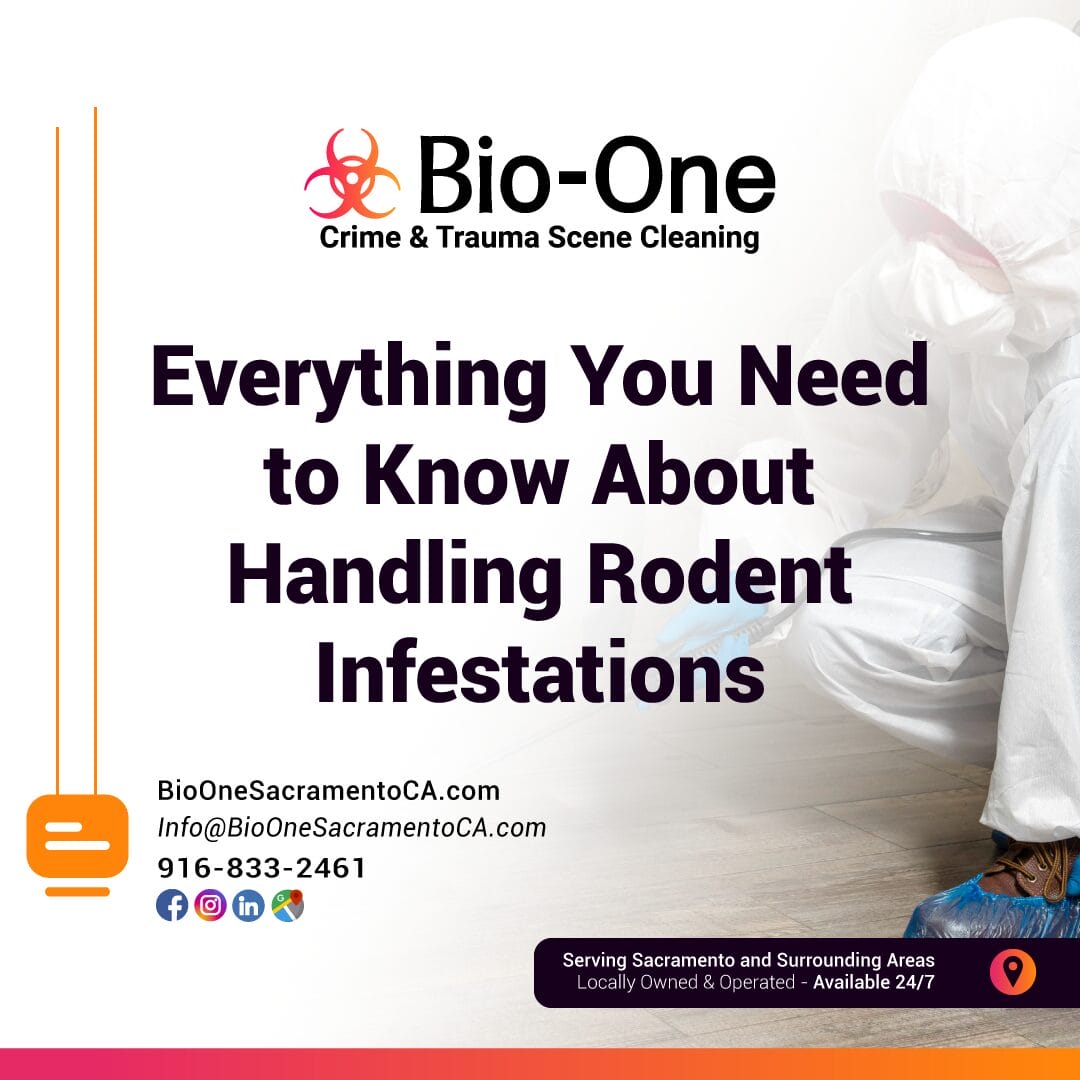
Nobody likes uninvited houseguests, especially the four-legged kind that scurry around at night, chew through wires, and leave unpleasant surprises in your pantry. We’re talking about rodent infestations. Not only are rats and mice unwelcome roommates, but they also pose some serious health and safety risks. If you’ve noticed a few too many droppings or heard suspicious scratching sounds behind your walls, this blog's for you.
Here, we’ll break down the key risks of rodent infestations, how to spot them, and—most importantly—what to do about it. Spoiler alert: if rats or mice have moved in, professional help should be your first call!
Rodents aren’t just gross—they’re dangerous. Here’s why ignoring a rodent problem is a bad idea:
Rodents can carry diseases like hantavirus, leptospirosis, and salmonella, which can be transmitted to humans through their droppings, urine, and saliva. For example, even sweeping up rodent droppings improperly could release harmful pathogens into the air. Nobody wants their spring cleaning routine to turn into a health hazard.
Rats and mice are relentless chewers. They’ll gnaw on everything from your food packaging to your electrical wiring (which could lead to house fires) and even the insulation in your walls. The longer they’re in your home, the higher the chances that they’ll leave devastation in their wake.
Got one mouse? You probably have more. Rodents reproduce at an alarming rate. A single pair of rats can multiply into hundreds within a year. The longer you wait to address the problem, the harder—and costlier—it is to eliminate.
Want to know the scary truth about how quickly rodent populations grow? Check out this info on rodent reproduction habits from the CDC.
The earlier you detect a rodent infestation, the easier it will be to control. Keep an eye out for these telltale signs:
Rodents leave behind pellet-shaped droppings close to food sources, pantries, or along baseboards. If you spot these, it’s a clear red flag.
Hear light scuttling noises at night? That’s not your imagination—it’s likely rodents in your walls or floorboards.
Rodents chew to keep their teeth sharp and short. You might notice bite marks on baseboards, furniture, or food packaging.
Rats and mice create little nests out of shredded paper, fabric, or insulation. Find one of these tucked away? It's time to take action.
A strong, musky smell could signal a rodent population nearby. Their urine and droppings leave an unmistakable stench, especially as the infestation grows.
If you’re noticing any of these signs, it’s time to get proactive. Don’t wait until rodents have taken over your home like it's their personal Airbnb.
Understanding why rodents picked your home can help you avoid future infestations. Some common culprits include:
Keep in mind that even the cleanest homes can fall victim. Rodents are resourceful creatures, and if they want in, they’ll find their way.
Looking for ideas on how to rodent-proof your home? Read these tips from the EPA.
Alright, so you’ve got a rodent problem. What now? Here are three essential steps you should take:
The longer you wait, the worse it gets. Rats and mice breed fast. Address the problem the moment you spot evidence of their presence.
DIY traps and poison might give you short-term relief, but they’re rarely enough for eliminating a full-blown infestation. Plus, incorrect use of rodenticides or traps can harm pets, wildlife, and even your family.
That’s where Bio-One Sacramento comes in. Our team specializes in removing rodent infestations, cleaning up contaminated areas, and restoring your home to a safe and healthy environment. Don’t go it alone—leave the dirty work to the experts.
Once your home is rodent-free, seal it up! Close up gaps around windows, doors, and vents. Store food in airtight containers. And, take out the trash regularly. A little prevention goes a long way toward keeping them from coming back.
Need help pinpointing entry points or contaminated areas? We offer inspection services that will leave no stone unturned. Learn more about our services here.
Sure, you might consider laying some traps or using over-the-counter repellents to save money, but here’s the thing—it rarely works long term. Rodents are smarter than you think, often learning how to avoid traps or outsmart deterrents. Plus, dealing with dead rodents or cleaning up waste can expose you to dangerous diseases if not handled properly. Yuck.
When it comes to infestations of this scale, calling in rodent control professionals isn’t just an option; it’s the best way to ensure your home and family stay safe.
For more info or to get started today, visit Bio-One Sacramento. We’re here to help.
Rodent infestations can feel overwhelming and downright gross, but the key is to act quickly and call in the pros. With the right knowledge (and a bit of elbow grease), you can get these pesky critters out of your home and keep them out for good.
Still have questions or concerns? Browse our site or start a consultation. Whether you’re dealing with an active infestation or just want to rodent-proof your home, Bio-One Sacramento has your back!

For those affected by hoarding, whether directly or indirectly, seeking help can be a challenging step. Unfortunately, misconceptions about hoarding cleanup services often prevent individuals and families from getting the support they need. At Bio-One of Sacramento, we understand how difficult it is to take that first step, and we're here to dispel harmful myths surrounding our work.
Below, we unravel five common misconceptions about hoarding cleanup services, providing clarity, compassion, and insight into how we help clients regain control of their spaces and lives.
One of the most prevalent misunderstandings about professional hoarding cleanup is that it boils down to tossing belongings into trash bags. However, hoarding cleanup is far more nuanced and thoughtful than that.
At Bio-One of Sacramento, respect for personal property and sentimental belongings is a top priority. Our team makes every effort to identify items of value, such as heirlooms, photographs, legal documents, and other sentimental possessions. Rather than indiscriminately discarding items, we collaborate with clients to make deliberate and mindful decisions about what to keep, donate, recycle, or dispose of.
Hoarding cleanup is about more than clearing clutter; it’s about creating a safer and healthier home environment while honoring the client’s emotional needs. Learn more about how we approach each cleanup with compassion and care on our homeless encampment and hoarding cleanup page.
Another harmful myth is the assumption that hoarding is a result of laziness or poor housekeeping. The truth is, hoarding is a complex mental health disorder that often stems from underlying conditions such as anxiety, obsessive-compulsive tendencies, or traumatic life events. According to the American Psychiatric Association, hoarding disorder goes beyond collecting items, featuring emotional distress about discarding possessions and a need to accumulate belongings.
A professional cleanup service not only understands the intricacies of the disorder but also prioritizes compassion in every step of the process. For example, we utilize discretion (our team often arrives in unmarked vehicles) and work collaboratively with family members, therapists, and support networks to ensure the client feels supported.
Our goal is not only to restore functionality to a living space but also to help individuals regain control of their environment without judgment.
Hoarding situations often develop over years, meaning it’s unrealistic to assume a single cleanup session can resolve deeply rooted issues. While professional cleanup services are efficient, hoarding cleanup is a step-by-step process that involves careful planning, sorting, and sanitizing. Swift, indiscriminate cleanup can overwhelm clients and even lead to relapse if underlying causes are not addressed.
At Bio-One of Sacramento, we approach each situation systematically:
At first glance, tackling a hoarding situation on your own might seem economical or manageable. However, hoarded properties often involve safety hazards such as pest infestations, mold, structural damage, and biohazards (e.g., expired food, human or animal waste). Cleaning without the proper training, tools, or safety measures can pose significant health risks.
Hoarding cleanup teams like ours are trained to handle:
Many individuals avoid seeking professional cleanup services because they fear stigma or judgment. However, reaching out for help with hoarding is an act of courage, not shame.
Hoarding affects millions of people across the country, and professional cleanup services exist to assist—not to judge. At Bio-One of Sacramento, our motto, “Help First, Business Second,” reflects our commitment to treating every client with empathy and dignity. Whether you’re calling on behalf of a loved one or seeking help for yourself, we are here to ensure you feel supported every step of the way.
Our testimonials section is filled with stories from clients who have transformed their homes and lives thanks to professional cleanup services.
Choosing the right team for hoarding cleanup is essential. At Bio-One of Sacramento, we are dedicated to providing:
Addressing a hoarding situation can feel overwhelming, but debunking these misconceptions is an important step in moving forward. By better understanding the thoughtful, respectful approach behind professional cleanup services, individuals and families can feel empowered to take action.
If you’re ready to restore health and order to your living space, reach out to Bio-One of Sacramento today. We can tackle even the most challenging situations with compassion and expertise, giving you the fresh start you deserve!
Hoarding is often more than just a collection of clutter; it’s a deeply rooted mental health challenge that can severely impact individuals and their loved ones. With risks ranging from emotional strain to serious health and safety hazards, addressing hoarding requires more than just cleaning out a space. A collaborative approach combining mental health support and professional cleanup is vital to truly tackle the issue in a holistic and sustainable way.
Mental health professionals play a key role in addressing the psychological and emotional roots of hoarding, while cleanup companies like Bio-One of Sacramento handle the physical aspects of the situation with expertise and compassion. Together, they offer individuals and families a path to recovery, safety, and a better quality of life.
Hoarding disorder is characterized by persistent difficulty discarding or parting with possessions, regardless of their actual value. This leads to an accumulation of items that congest living spaces, interfere with daily activities, and can even create dangerous conditions in the home.
While hoarding might seem like a “simple” behavioral issue, it is often linked to deeper mental health challenges. Common underlying conditions include:
Hoarding is a complex disorder, and its resolution requires more than just cleaning out a home. For lasting change, the psychological roots need to be addressed. Mental health professionals approach this through evidence-based interventions such as therapy, counseling, and skill-building.
CBT is considered the gold standard for treating hoarding disorder. Therapists help individuals identify unhelpful thoughts and beliefs about their possessions, such as “I might need this someday” or “This object gives my life meaning.” By challenging these thought patterns, the individual can begin to unlearn the compulsive behaviors that lead to hoarding.
For many hoarders, their accumulation of possessions is closely tied to emotional struggles, such as grief or unresolved trauma. Mental health professionals create a safe environment where clients can explore these feelings and develop healthier coping strategies.
Many individuals who hoard struggle with decision-making, organization, and time management. Mental health treatment often includes teaching practical skills in these areas to help clients manage their living spaces better in the long term.
Hoarding often affects more than just the individual; family members can feel helpless, frustrated, or even estranged. Therapists can work with families to improve communication, set boundaries, and foster supportive relationships that encourage recovery.
While mental health professionals work on these psychological components, the physical environment cannot be ignored. A clutter-free and safe living space is crucial for the person’s mental well-being and recovery. That’s where the expertise of Bio-One of Sacramento comes in.
While mental health professionals focus on the emotional and behavioral aspects of hoarding, Bio-One of Sacramento specializes in handling physical cleanup, ensuring a safe and sanitary environment for all involved.
Hoarding situations often involve much more than clutter. Homes may contain biohazards like mold, rodent droppings, or decayed food, all of which pose serious risks to health and safety. Bio-One of Sacramento is uniquely equipped to handle these challenges with professionalism, discretion, and respect.
Each hoarding cleanup project begins with an assessment to understand the extent of the challenge. The Bio-One team then develops a step-by-step plan to prioritize safety while making the space livable again.
Hoarding environments often harbor biohazards that require specialized equipment and protocols to safely remove. From pest infestations to potential contaminants, Bio-One ensures these hazards are eliminated thoroughly and responsibly.
Bio-One of Sacramento understands that hoarding is a sensitive issue. Their team works with compassion and empathy, avoiding judgment and focusing on solutions. This approach helps build trust with clients and families, making the process less overwhelming.
Hoarding cleanup doesn’t just aim to empty out a space; it also includes sanitizing and restoring the environment to make it safe and welcoming for those living there.
The Bio-One team is experienced in working alongside therapists, counselors, and social workers to ensure the cleanup process aligns with the emotional needs of the individual recovering from hoarding disorder. This collaboration minimizes the trauma associated with parting with possessions and helps create a smooth transition to a healthier lifestyle.
Whether you’re a family member, friend, or someone dealing with hoarding firsthand, it’s important to approach the situation with care and understanding. Here are some actionable tips for navigating the physical and emotional challenges of hoarding recovery:
Hoarding is not just about being “messy” or “lazy.” It’s a deeply rooted mental health challenge. Approach conversations with compassion and an open mind.
Mental health professionals are trained to address hoarding disorder in a way that promotes sustainable change. Encourage your loved one to seek therapy and support.
Cleaning up a hoarded space is overwhelming and potentially dangerous without the proper training. Enlist professionals like Bio-One of Sacramento who have the tools and expertise to handle the job safely and effectively.
Foster a collaborative relationship between therapists, cleanup crews, and family members. This team approach ensures that both the mental and physical aspects of hoarding are addressed thoroughly.
For individuals struggling with hoarding, starting small can reduce overwhelm. Focus on one area or category of items at a time, and celebrate progress along the way. Having professionals on hand can make the process more manageable.
Hoarding recovery is not a one-step process; it’s a journey that requires addressing both the mental and physical impact of the disorder. Mental health professionals provide the emotional support and tools needed to tackle the behavioral roots, while Bio-One of Sacramento ensures a safe, clean, and livable physical environment.
If you or a loved one are struggling with hoarding, don’t hesitate to reach out for help. Whether it’s through therapy, cleanup services, or a combination of both, taking that first step paves the way for a healthier future.

When you hear the term “crime scene cleanup,” your mind might immediately jump to scenes from TV dramas or movies. A team sweeps in with gloves and masks, cleans up in a matter of minutes, and disappears into the night, leaving nothing but a spotless space. While that might make for great entertainment, the reality of crime scene cleanup is far different. Misunderstandings surrounding this field are common, and they can lead to confusion and even unsafe situations.
At Bio-One of Sacramento, we’ve encountered plenty of misconceptions about our profession, and today, we want to set the record straight. Here are the top five myths about crime scene cleanup, debunked.
A common belief is that after law enforcement investigates a crime, they also handle the cleanup. This is not true. Police officers, detectives, or coroners are responsible for collecting evidence and ensuring all investigative procedures are conducted—but that’s where their job ends.
The cleanup is left to property owners, families, or, ideally, a professional biohazard cleanup service like Bio-One of Sacramento. Crime scenes often involve dangerous materials like blood, bodily fluids, or biohazards that pose serious health risks. Cleaning these up requires specialized training, equipment, and licensing to ensure safety and compliance with local regulations.
The truth? Crime scene cleanup is a responsibility best left to trained professionals with the expertise to handle it both safely and effectively.
TV might give the impression that cleaning up a crime scene is a fast and simple process, but this couldn’t be further from the truth. Crime scenes often involve complex and hazardous conditions. Blood and bodily fluids can seep into floors, walls, and furniture, requiring extensive remediation to ensure contaminants are fully removed. Odors can linger, making thorough deodorization a crucial step.
On top of that, there are emotional and psychological factors in play. Families or property owners may be grieving or in shock, making the presence of compassionate, experienced cleanup technicians essential.
The truth? Crime scene cleanup is a meticulous process. It involves careful planning, specialized cleaning solutions, professional-grade equipment, and extensive safety measures to restore the space to a safe and livable condition.
The idea of saving money by tackling a crime scene cleanup on your own can be tempting, but it’s not just about scrubbing away stains. Without the right training and equipment, attempting to clean a scene yourself puts both your health and your property’s safety at risk.
For instance, biohazardous materials like blood or bodily fluids can contain pathogens like hepatitis or HIV. Without proper handling and disposal methods, the contamination risk is significant. Additionally, many states have strict regulations about how biohazards should be handled and disposed of, and failing to follow these can result in legal troubles.
The truth? Professional biohazard cleanup services, like those provided by Bio-One of Sacramento, protect you from danger and ensure the scene is restored in compliance with legal and safety standards.
When people think about crime scene cleanup, they tend to focus on the physical act of cleaning. But the role of professionals extends far beyond that. At Bio-One, we understand the emotional toll a traumatic event can take, and we approach every job with compassion and discretion.
Our team works closely with families, property managers, and law enforcement to ensure the process is as stress-free as possible. We show respect for personal belongings, work discreetly with unmarked vehicles, and prioritize communication throughout the process.
The truth? Crime scene cleanup isn’t just about cleaning; it’s about restoring both physical spaces and peace of mind.
Sometimes, crime scenes don’t look gruesome at first glance, leading people to believe cleanup isn’t necessary. However, invisible dangers can linger. Pathogens from blood or bodily fluids aren’t always visible, and surfaces that look clean may still be contaminated.
Without proper decontamination, these issues can lead to serious health risks for anyone who enters the area. Professionals can identify and remove contaminants that might otherwise be missed and ensure the space is truly safe.
The truth? Even if the scene appears clean, professional cleanup is critical to remove health hazards and restore safety.
At Bio-One of Sacramento, we specialize in handling the toughest situations with compassion, experience, and respect. Our team is trained to safely and discreetly clean crime scenes, biohazards, hoarding situations, and more. We take the burden off your shoulders, so you can focus on healing and moving forward.
If you’re in need of professional crime scene cleanup in Sacramento or the surrounding areas, don’t wait. Contact us at 916-833-2461 or visit our website to request a service. Remember, when it comes to biohazard cleanup, it’s always better to trust the professionals. Bio-One of Sacramento is here for you, every step of the way.

Dealing with a biohazard incident in your home can feel overwhelming. From bloodborne pathogens to chemical spills, these situations pose serious health risks if not handled correctly. Knowing what steps to take—and what to avoid—is crucial for ensuring your safety and restoring your space. That’s why we’ve put together this guide to help you understand the do’s and don’ts after a biohazard incident. If you need professional help, biohazard cleanup services like those offered by Bio-One of Sacramento are the safest and most effective solution.
A biohazard incident involves biological substances that pose a threat to human health and the environment. Common examples include:
Your immediate priority is to ensure the safety of everyone in the household. If possible, evacuate the affected area and limit access to prevent potential exposure to harmful pathogens or hazards. Wear protective gear, such as gloves and a mask, to minimize contact with contaminants.
Determine the scope of the incident. Is it contained in a small area, or has it spread? For example, a chemical spill in one room is different from a hoarding situation that involves the entire house. This assessment will help you communicate effectively with cleanup professionals.

While it may be tempting to handle the cleanup yourself, biohazards require specialized training, equipment, and disposal protocols. Bio-One of Sacramento offers experienced biohazard cleanup services to safely manage and remediate potentially dangerous situations. Learn more about our services on our website.
Professionals will follow a thorough process that includes assessment, containment, cleanup, disinfection, and waste disposal. This ensures your home is restored to a safe and livable condition.
Some biohazard incidents, such as chemical spills or crime scenes, may require notification of local authorities. They may need to investigate or ensure the environment has been properly secured.
Take photos and keep detailed notes. If the incident is covered by insurance, your provider may require this documentation for claims. The professionals you hire can often assist with this process.
Cleaning up a biohazard without proper training and equipment can result in serious health risks. For example, exposure to bloodborne pathogens such as hepatitis and HIV can occur without adequate protection and protocols.
Professional cleanup teams use specialized tools and chemicals to safely handle these situations. Trying to manage it yourself might also lead to improper disposal, which can have legal implications.
Industrial-grade disinfectants are designed to eliminate pathogens effectively, while most household cleaning products may only mask the issue. Using the wrong product could spread the contamination further or damage surfaces in your home.
The longer a biohazard remains unaddressed, the greater the risk to your health and property. For example, unattended decomposition can result in harmful bacteria leaking into floors and walls, making remediation more complex and costly. Contact biohazard cleanup services promptly to mitigate risks.
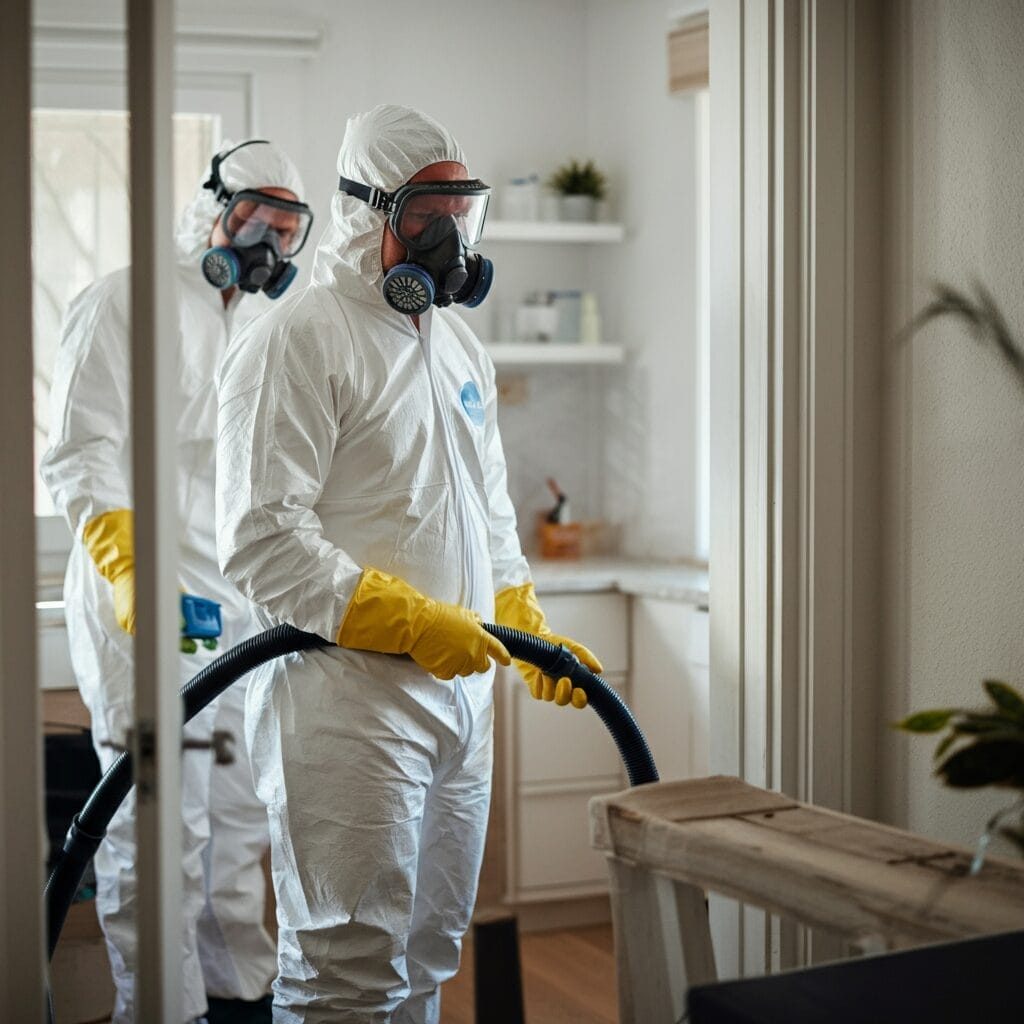
Professional biohazard cleanup teams, like those at Bio-One of Sacramento, are trained to handle hazardous materials with precision and care. Here’s why hiring experts is essential:
Dealing with a biohazard is stressful, but you don’t have to handle it alone. Follow the steps outlined above to safeguard your health and home. When in doubt, always contact experts like Bio-One of Sacramento for reliable biohazard cleanup services.
We’re here to help. Visit our website or call us today to learn more about our full range of cleanup solutions. You can count on our team to handle these situations with discretion, professionalism, and care.
A biohazard incident requires urgent attention, but navigating it doesn’t have to feel impossible. By prioritizing safety, knowing what to do, and reaching out for professional help, you can restore your home and peace of mind. Don’t hesitate to act when it comes to such serious situations. Your health and safety are worth it!
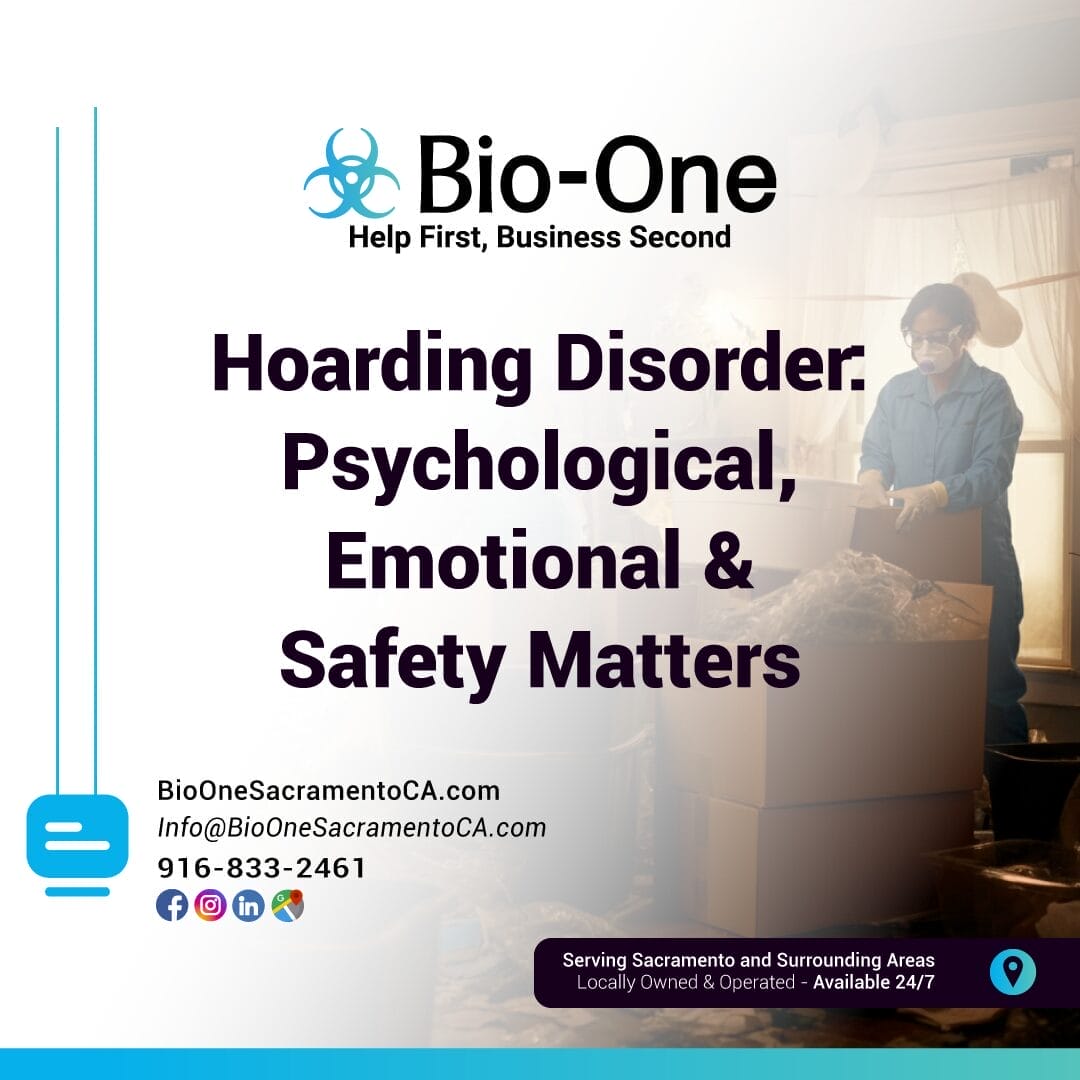
Hoarding disorder is a complex and often misunderstood condition that goes far beyond clutter or disorganization. It’s characterized by the excessive accumulation of items, difficulty discarding possessions, and significant distress or impairment as a result. For families and friends of individuals who struggle with hoarding, it can be a heartbreaking experience, even more so if they don’t know how to approach the problem effectively.
Cleaning up a hoarded home is no simple matter. Beyond the physical mess lies a web of psychological, emotional, and even safety concerns. This blog will explore the deeper aspects of hoarding, outline why safety and compassion must go hand in hand when addressing it, and provide actionable guidance on helping a loved one tackle the issue. It will also offer insight into why professional cleanup services play an essential role in achieving a resolution that’s both safe and respectful.
Hoarding is often linked to underlying mental health challenges, which makes it crucial to approach the issue with understanding and care. According to the American Psychiatric Association, hoarding disorder is often accompanied by other conditions such as anxiety, depression, or obsessive-compulsive disorder (OCD). Individuals with hoarding disorder may attach emotional value to their possessions in ways that don’t seem logical to others. For example, they might believe that these items provide a sense of safety, symbolize important memories, or could “someday” be useful.
For many, the very idea of discarding items triggers intense emotional distress. This fear often leads to avoidance, creating a cycle where the hoard only continues to grow. What might look like stubbornness or neglect to an outsider is often the result of deep emotional pain and a struggle to cope with overwhelming thoughts.
The first step in addressing a hoarding situation is understanding that the behavior isn’t laziness or defiance, but a sign of a serious underlying issue. Compassion goes a long way in helping someone feel supported rather than criticized, which is critical for encouraging change.
Aside from the emotional and psychological toll, hoarding poses serious health and safety risks both to the person struggling with the disorder and to those around them. These risks include:
Hoarded homes often become breeding grounds for mold, dust, and pest infestations, contributing to poor air quality and spreading allergens. The presence of decaying food, animal waste, or unsanitary conditions can also expose inhabitants to dangerous pathogens. For those with preexisting health conditions like asthma, the environment can be especially hazardous.
Excessive clutter increases the risk of fires. With piles of combustible material like paper and fabric blocking pathways, escape routes in the event of an emergency can be obstructed. Firefighters often face significant challenges navigating hoarded homes, putting everyone’s safety at greater risk.
The sheer weight of accumulated items can strain floors and walls, causing long-term structural damage to a home. Over time, this might result in costly repairs or even make the property unsafe to inhabit.
Narrow pathways, unstable piles, and the lack of clear walking space heighten the risk of falls and physical injuries. Seniors living in hoarded homes are especially vulnerable to these hazards.
If you have a family member or close friend struggling with hoarding, your first instinct might be to clear the clutter yourself or confront them about the mess. However, an unsympathetic or aggressive approach can backfire, leading to increased resistance and emotional harm. Here are some compassionate steps you can take:
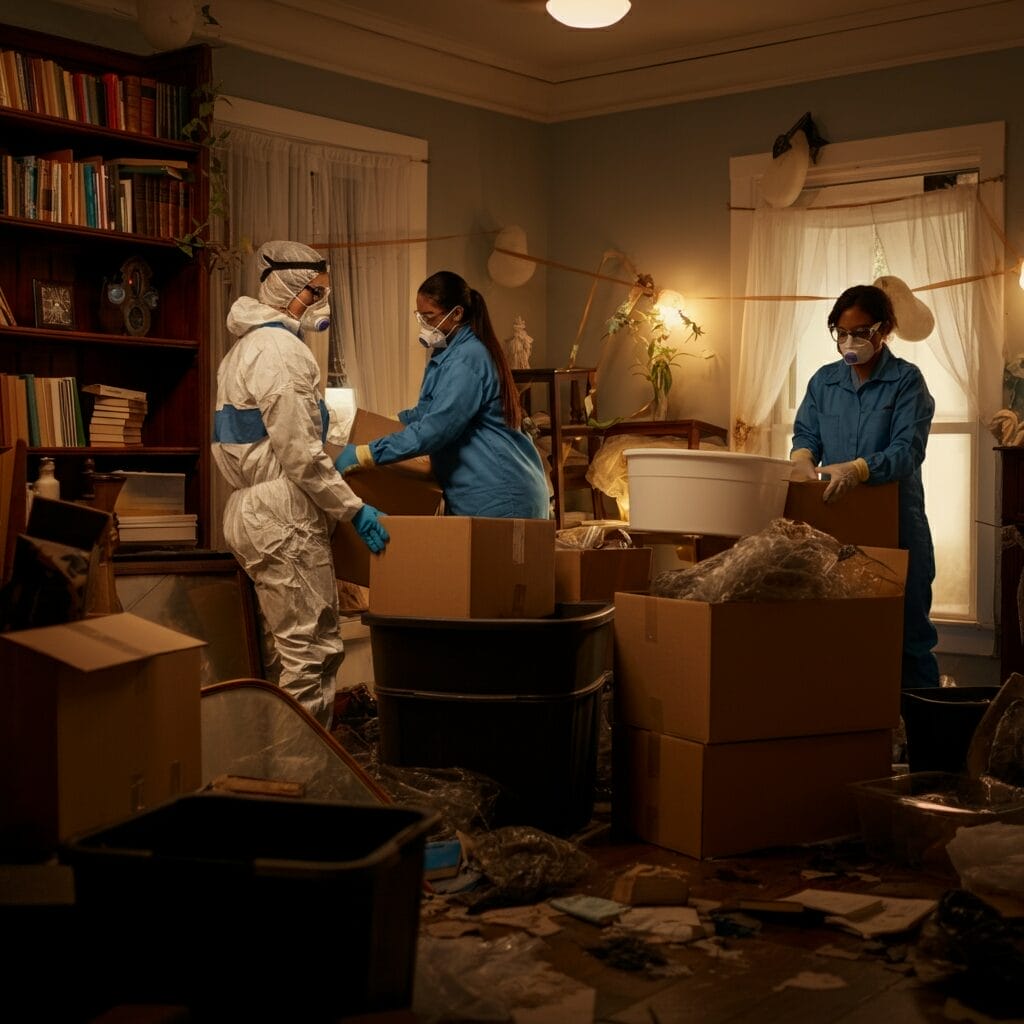
Understanding hoarding disorder can help you empathize with your loved one and recognize the challenges they face. Learning more about their emotional attachment to items can guide you in responding with patience.
Approach the topic without judgment. Use non-confrontational language and express concern for their well-being. For example, you might say, “I’ve noticed you have a lot of things in your home, and I’m worried about your safety.”
Suggest talking to a therapist or counselor who specializes in hoarding or mental health issues. Recovery from hoarding often requires professional guidance to address the underlying emotions driving the behavior.
Rather than attempting to clear out an entire home in one day, encourage your loved one to focus on manageable tasks. This could be as simple as clearing off a single table or sorting through a small box of items.
Resist the urge to throw items away on their behalf. This can feel like a violation of trust and may cause them to retreat further into their hoarding behavior. Any cleanup efforts should be done with their input and cooperation.
Change doesn’t happen overnight. Progress may be slow, and there will likely be setbacks along the way. Offer ongoing support and reassurance that they’re not alone in dealing with their challenges.
Hoarding cleanup can become overwhelming, especially in severe cases where health and safety risks are high. Professional cleanup services are often the most effective way to restore a hoarded home while minimizing emotional distress for the individual and their family.
If you or someone you care about needs assistance, consider reaching out to trained professionals who can help restore both the physical and emotional well-being of everyone involved. Together, we can handle the toughest challenges with respect and care.
For more insight into hoarding behaviors, learn about the psychological causes of hoarding and how they manifest. To understand how to approach and support a loved one, check this guide on helping someone with hoarding disorder. These resources provide valuable tools and knowledge to help manage and overcome hoarding challenges effectively.
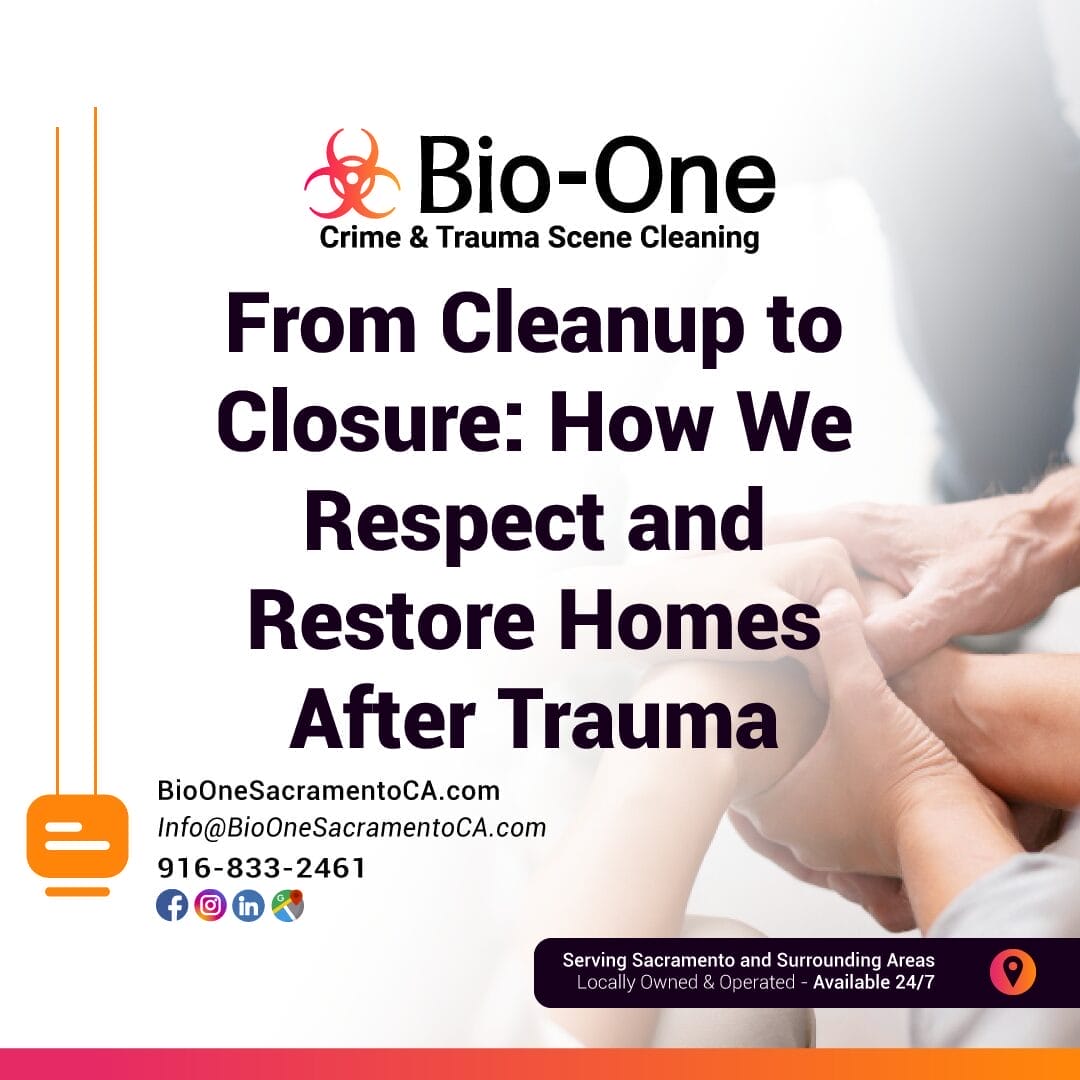
Trauma can leave more than physical damage in its wake. It can impact the very sense of safety and comfort a home should provide. At Bio-One of Sacramento, we specialize in turning these challenging times into an opportunity for healing through our expert trauma restoration services. Our goal isn’t just to clean up the physical aftermath but also to respect the emotional weight of the situation and restore the home as a place of peace and renewal.
Here, we outline how we approach trauma restoration with compassion, precision, and professionalism, guiding families and property owners from chaos to closure.
At Bio-One of Sacramento, we understand that every trauma scene is not just a job site but a deeply personal space. Whether it involves a crime scene, unattended death, or complex biohazard contamination, we ensure that our approach is rooted in empathy and respect. This starts with listening.
During our initial consultation, we take the time to understand your concerns, answer questions, and develop an action plan that prioritizes your well-being. Our team is trained to handle emotionally sensitive situations, ensuring that we work with the utmost discretion and kindness.
For those dealing with the emotional toll of trauma, additional support is invaluable. Organizations like SAMHSA’s National Helpline offer free, 24/7 assistance to connect you with mental health resources during difficult times.
Before beginning any cleanup, our trauma restoration process starts with a meticulous assessment. This step is critical not only for providing an accurate cost estimate but also for ensuring that all areas of concern are addressed. Trauma scenes often contain hidden risks like biohazard contamination, which must be identified and handled properly to prevent long-term health complications.
Our assessment includes evaluating the following:
We prioritize transparency during this stage, explaining each step of the plan to make the process as stress-free for you as possible.
Trauma restoration is not just about cleaning surfaces. At Bio-One of Sacramento, our certified professionals adhere to OSHA and CDC biohazard safety guidelines to ensure the highest levels of sanitation and disinfection.
Key elements of our process include:
By thoroughly addressing biohazards, we provide not just cleanliness but peace of mind that the space is truly safe to inhabit again.
One of the lingering challenges in trauma restoration is dealing with odors and damage caused by biohazards or accidents. Odors, particularly from decomposition or smoke, can seep into walls, fabrics, and floorboards, making professional techniques essential for complete remediation.
At Bio-One of Sacramento, our team specialists excel at odor removal and structural restoration. Using advanced technology like air scrubbers and thermal fogging, we don’t just mask odors—we eliminate them at their source. Additionally, we will address areas of structural damage, ensuring that your home is restored both visually and functionally.
Trauma restoration isn’t just about cleaning up a space; it’s about helping individuals and families find closure. To that end, we often collaborate with local mental health professionals, victim advocates, and government agencies to connect our clients with the right resources. Some helpful starting points include the American Psychological Association’s trauma resources and community victim support programs.
We also provide education to help clients maintain the restored space and prevent future issues. For instance, tips on proper cleaning practices and regular property inspections can go a long way in keeping the environment safe and welcoming.
What sets Bio-One of Sacramento apart in trauma restoration is our commitment to balancing technical expertise with human compassion. We don’t see a trauma scene as just a job; we see it as an opportunity to help individuals regain their sense of home and normalcy.
Here’s why families and property owners trust us:
Trauma restoration goes beyond physical cleanup; it’s about allowing a new chapter to begin. At Bio-One of Sacramento, we take pride in supporting families and individuals through what is often one of the most difficult periods of their lives. With our expertise, compassion, and commitment, we ensure that the path from cleanup to closure is as smooth and restorative as possible.
If you need trauma restoration services or have questions about the process, don’t hesitate to contact Bio-One of Sacramento today. Together, we can restore your home and help you move forward.
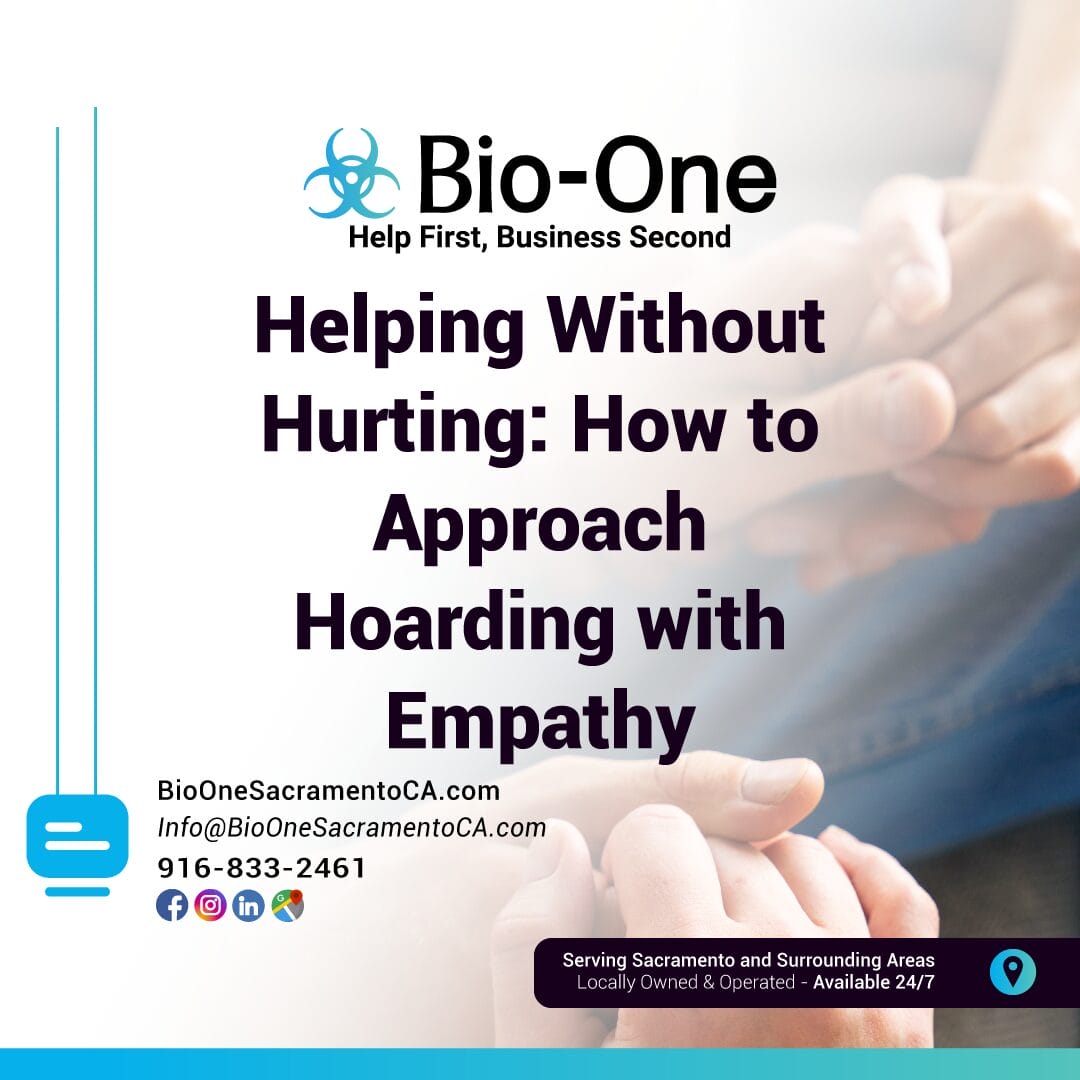
Hoarding can be a challenging topic to discuss, especially when it involves someone you care about. Watching a loved one struggle with hoarding can leave you feeling helpless, overwhelmed, and uncertain about what to do. But approaching the situation with understanding, patience, and compassion is key to providing effective hoarding support.
This guide will help you better understand hoarding, offer strategies for starting difficult conversations, and highlight steps you can take to offer meaningful help without causing harm.
Hoarding is more than keeping too many things; it’s a complex mental health condition that can affect a person’s daily life, relationships, and well-being. It’s often linked to anxiety, depression, or trauma, making it difficult for the individual to part with possessions, no matter their condition or value.
The living conditions created by hoarding often pose safety risks. Clutter can lead to falls, fire hazards, and even biohazards, depending on the severity of the situation. These dangers highlight the importance of addressing hoarding in a supportive and proactive way.
Before initiating a conversation, take time to learn about hoarding. Understanding what your loved one is going through will help you approach them with empathy and avoid judgment. The International OCD Foundation provides valuable resources on hoarding disorder, helping you see it from their perspective. This foundational knowledge can build a bridge of understanding, an essential tool for effective communication.
Consider reading expert articles or consulting with local professionals like therapists who specialize in hoarding behaviors. By learning more, you’ll not only feel better equipped but also show your loved one that your intention comes from a place of care, not criticism.
Starting a conversation with someone who hoards can feel intimidating. The key is to foster trust and safety. Here are a few tips to guide you:
Once you’ve opened the conversation, explore ways to offer support. Remember, the goal is to help them feel empowered, not forced. Here are effective strategies to explore:
Supporting a loved one in seeking professional guidance can be a game-changer. A therapist or counselor who specializes in hoarding can provide tailored coping strategies and solutions. You can help by finding local mental health professionals or directing them to resources like SAMHSA’s Behavioral Health Treatment Locator.
Severe hoarding situations often require expert assistance. Reputable cleanup services like Bio-One Sacramento specialize in compassionate and discreet hoarding cleanup. They prioritize respect for the individual while ensuring the space becomes safe and livable again. Sharing this type of resource can relieve some burden and show your loved one that they’re not alone in this process.
Instead of tackling the entire issue at once, focus on incremental progress. For example, suggest sorting through one small area together. This makes the task less overwhelming and builds a sense of accomplishment. Tools like checklists or decluttering apps can guide the process without feeling overbearing.
Change doesn’t happen overnight, especially when dealing with deeply ingrained habits tied to emotional struggles. It’s crucial to practice patience and continue showing empathy, even if progress feels slow. Celebrate small victories along the way and reassure your loved one that you’re there for them unconditionally.
If you find yourself feeling frustrated or overwhelmed, don’t hesitate to seek support for yourself. Talking to a therapist or joining a support group for friends and family of individuals with hoarding disorder can provide valuable encouragement and advice. It’s important to prioritize your well-being as you support your loved one.
By approaching hoarding with empathy and understanding, you can help your loved one move toward a healthier and more secure life. While the process may not be easy, your willingness to offer compassionate hoarding support can make all the difference in their path to recovery.
For more information on professional hoarding cleanup services, visit Bio-One Sacramento. Additionally, resources like the International OCD Foundation offer valuable insights into hoarding disorder and practical guidance for families navigating these challenges.